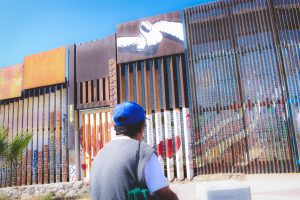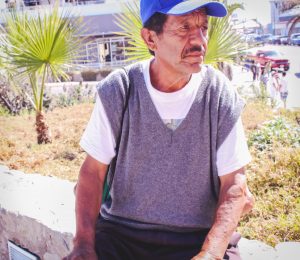by Analucía Partida Borrego

Manuel looking at where he had once crossed the border 30 years ago; now that same place is heavily reinforced and guarded by border patrol.
“When I crossed through here, I didn’t know this. It’s not even this first wall; it’s the second one over there. And when I saw there was barbed wire on top and on the bottom, I said, “Am I in China? Is this the great wall of China?” – Manuel. Tijuana, B.C., Mexico
It is difficult to imagine the 3200 km Mexican-U.S. border without a wall. Nowhere is enhanced national security more visible than in the most trafficked border crossing in the Western Hemisphere between Tijuana and San Diego.
The scene was not always like this. If one had driven to the San Diego – Tijuana border in the early 90’s, the panorama would have been starkly different from today: a fence replete with holes, where migrants could look through while patiently waiting for their opportunity to cross, has become a double border fence with barbed wire, heightened security sensors, and constant border patrol observation.
What was once considered “the gateway for the majority of unauthorized entries into the United States” now has one of the lowest levels of unauthorized entries of border crossings. With the implementation in San Diego of Operation Gatekeeper, a measure aimed at increasing the ability of U.S. authorities to control the movement of unauthorized people and goods across the U.S. – Mexico border, the flow of unauthorized migrants attempting to cross shifted from this urban area towards a less-guarded entry: the unforgiving desert. Across the border, strategies similar to Operation Gatekeeper were put in place.
The result of these measures came with an added expense: the lives of thousands of migrants. Since the all-time high of 492 deaths in 2005, there has been a decrease in migrant fatalities, now averaging around 350 per year.
Another long-term effect that resulted from the increase in border security near San Diego was Tijuana’s demographic composition. Tijuana, long a city of migrants, is now home to thousands of deportees. An average of 480 Mexican nationals are deported daily, – or as the government calls it, removed – some 90 of which are sent to Tijuana.
Deportees in Tijuana and other border cities are susceptible to a number of vulnerabilities. Most have never set foot in Tijuana. Some left Mexico during their childhood years and feel that their country of origin is a stranger to them. Others have lost contact with their families who still live in Mexico and are unsure where to go. They are often given a week to stay in a shelter before they must find their own form of sustainability.
Deportees also battle prejudices, both in the U.S. and Mexico. Many believe that people are deported due to criminal acts. This is unsurprising due to the political rhetoric.
In 2014, President Obama said, “Over the past six years, deportations of criminals are up 80% and that’s why we’re going to keep focusing enforcement resources on actual threats to our security. Felons, not families. Criminals, not children.” Mr. Obama had been receiving a lot of pressure from advocates of immigration reform and wanted to reassure the public that the thousands of deportations under his administration were fair and necessary. Obama’s statement echoes previous administration’s justification of detainment and deportation that proceeds in creating a single narrative that excludes thousands of voices and stories.
According to U.S. Immigration and Customs Enforcement (ICE) data on removals, in the fiscal year of 2015, 59% of removals were convicted criminals, while 41% were non-criminal immigration violators. Of the latter, the vast majority – 94% – were apprehended at or near the border. 91% of internal removals were convicted criminals.
However, there is more than meets the eye. A more thorough analysis on the definition of “convicted criminal” reveals a different angle to the political rhetoric and ICE’s data. A 2014 New York Times analysis of internal government records shows that between 2008 and 2014, 20% of nearly two million deportation cases involved people convicted of serious crimes. Two-thirds involved people who had either no criminal record or minor infractions.
What this type of labeling fails to shed light on is that most convicted criminals who are deported committed minor offenses such as multiple traffic violations, driving under the influence, or unauthorized entries or re-entries to the country. But these migrants are placed in the same category as people with serious offenses, such as drug-related cases or murder.
Once in Tijuana, those deportees that chose to stay in the city are forced to face discrimination and prejudice. They are not easily employable, partly due to a difficulty many find in retrieving their Mexican ID or birth certificate and partly due to the insecurity they face when an employer discovers that they have been deported.
Manuel takes a long look at the wall, before speaking again.
wall, before speaking again.
“I never thought I would live again in Mexico. I was 60 years old when I was deported. I was leaving work and was stopped at a checkpoint. They found out that I had been working all of these years without papers,” he said, fiddling with a small pack of gum he sold for 1 peso each (0.049 USD) to make a living.
“I never committed a crime or went to jail. My only crime was being illegal in the country.”
Author bio: Analucía has spent most of her life living on both sides of the Tijuana/San Diego border. She is the co founder of Alza la Voz Glob, a freelance human rights network that facilitates dialogue around compelling issues.
Photo credit: All pictures used were taken by the author.

